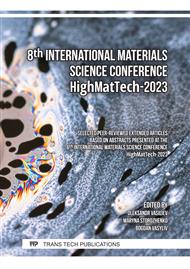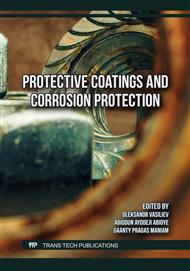[1]
Dwivedi D. K., (2018), Surface Engineering. Enhancing Life of Tribological Components, New Delhi: Springer Pvt. Ltd., ISBN 978-81-322-3777-8
DOI: 10.1007/978-81-322-3779-2
Google Scholar
[2]
Dychtoń K., Kocurek P., Rokicki P., Wierzba B., Drajewicz M., Sieniawski J., (2016). Microstructure and residual stress in AMS 6308 steel after vacuum carburizing and gas quenching, Acta Phisica Polonica A, Vol. 130, Iss. 4, pp.953-955
DOI: 10.12693/APhysPolA.130.953
Google Scholar
[3]
Habig K. H., Wear Protection of Steels by Boriding, Vanadizing, Nitriding, Carburising and Hardening," Materials in Engineering, 2 (1980) 2. pp.83-92
DOI: 10.1016/0261-3069(80)90018-7
Google Scholar
[4]
Drajewicz M., Góral M, Pytel M., Koscielniak B., Kubaszek T., Wierzba p., Cichosz P., The Duplex Coating Formation Using Plasma Nitriding and CrN PVD Deposition on X39CrMo17-1 Stainless Steel, Solid State Phenomena, 320(2021), 43-48
DOI: 10.4028/www.scientific.net/SSP.320.43
Google Scholar
[5]
Campos-Silva I., Ortiz-Dominguez M., Martinez Trinidat., Lopez-Perrusqia N., Hernandez-Sanchez E., Ramirez-Sandoval G. Escobar-Galindo R., , Properties and Characterisation of Hard Coatings obtained by Boriding: An Overview, Defect and Diffusion Forum, Vol. 297-301 (2010), pp.1284-1289
DOI: 10.4028/www.scientific.net/DDF.297-301.1284
Google Scholar
[6]
Jain V. Sundararajan G.,. Influence of the pack thickness of the boronizing mixture on the boriding of steel, Surface Coating and Technology, 149 (2002) 1, pp.21-26
DOI: 10.1016/S0257-8972(01)01385-8
Google Scholar
[7]
Yu L. G., Chen X. J., Khor K. A. I, Sundararajan G..,. FeB/Fe2B phase transfor-mation during SPS pack-boriding: Boride layer growth kinetics, Acta Materialia, 53 (2005) 8, pp.2361-2368
DOI: 10.1016/j.actamat.2005.01.043
Google Scholar
[8]
Kulka M.,. Current Trends in Boriding: Techniques, Springer Nature Switzerland AG, 2019, ISSN 1612-1317
DOI: 10.1007/978-3-030-06782-3
Google Scholar
[9]
Drajewicz M., Przybyło A, Jopek J., Góral M, Kościelniak B., Ochał K., Kubaszek T.,., Dychtoń K., Woźniak M., Kwaśniewski P., Kawecki P., Gluchowski W, Lagoda M.,. The Diffusion Coatings for Industrial Tool Application, Manufacturing Technology, 22 (2022) 5, pp.530-541
DOI: 10.21062/mft.2022.066
Google Scholar
[10]
Drajewicz M., Góral M., Kościelniak B., Ochał K., Kubaszek T., Pytel M., Wierzba P., Wojtynek R., The Influence of Process Parameters on Structure and Phase Composition of Boride Coatings Obtained on X39CrMo17-1 Stainless Steel, Solid State Phenomena, 320 (2021), 55-59
DOI: 10.4028/www.scientific.net/SSP.320.55
Google Scholar
[11]
A. Y. Sahin, M. E. Turan, Effect of boronizing process on wear properties of 16MnCr5 steels, Journal of Steel Research and development, 3 (2022) 2, 8-15
Google Scholar
[12]
Blazon M., Stranojevic B., Veljkovic, Effect of alloying elements on the formation of boride layer on steel, Scripta Metallurgica 9 (1975) 11, 1153-1156
DOI: 10.1016/0036-9748(75)90397-X
Google Scholar
[13]
Petek-Owiana A., The structure and properties of iron alloys with various chemical compositions after diffusional boronizing, Tribologia, 5 (2017), 65-71
DOI: 10.5604/01.3001.0010.5905
Google Scholar
[14]
Carbucccio M., Palombarini G., Effect of alloying elements on the growth of iron boride coatings, Journal of Materials Science Letters, 6 (1987), 1147-1149
DOI: 10.1007/BF01729165
Google Scholar
[15]
K. Przybyłowicz, Teoria i praktyka borowania stali, Kielce: Politechnika Świętokszyska, 2000.
Google Scholar
[16]
Guo P, Ma S, Jiao M, Lv P, Xing J, Xu L, Huang Z. Effect of Chromium on Microstructure and Oxidation Wear Behavior of High-Boron High-Speed Steel at Elevated Temperatures. Materials. 15 (2022) 2, 557
DOI: 10.3390/ma15020557
Google Scholar



